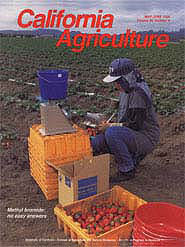All Issues

Methyl bromide: no easy answers
Cover:
Preparing for the methyl bromide phaseout, strawberry researchers are studying the alternatives to the standard methyl bromide-chloropicrin soil fumigation. At this site in Watsonville, they are evaluating the efficacy of four other soil treatments – chloropicrin alone, 1,3-D plus chloropicrin, metam sodium and no treatment. This worker is culling and weighing fruit to determine how much of the total yield is marketable. Photo by Jack Kelly Clark.
May-June 1994
Volume 48, Number 3
Volume 48, Number 3





